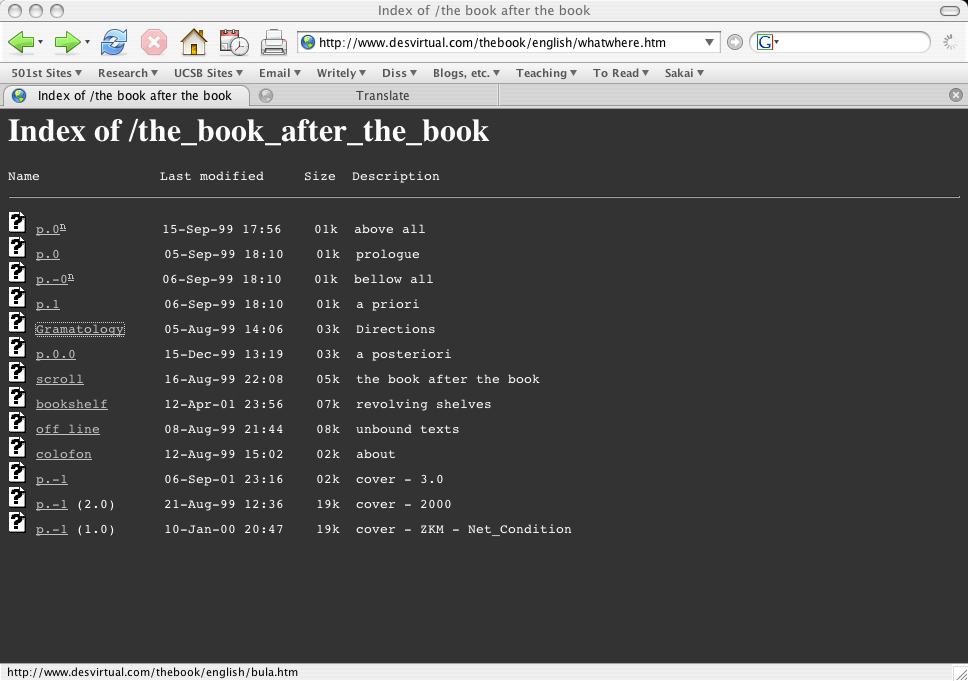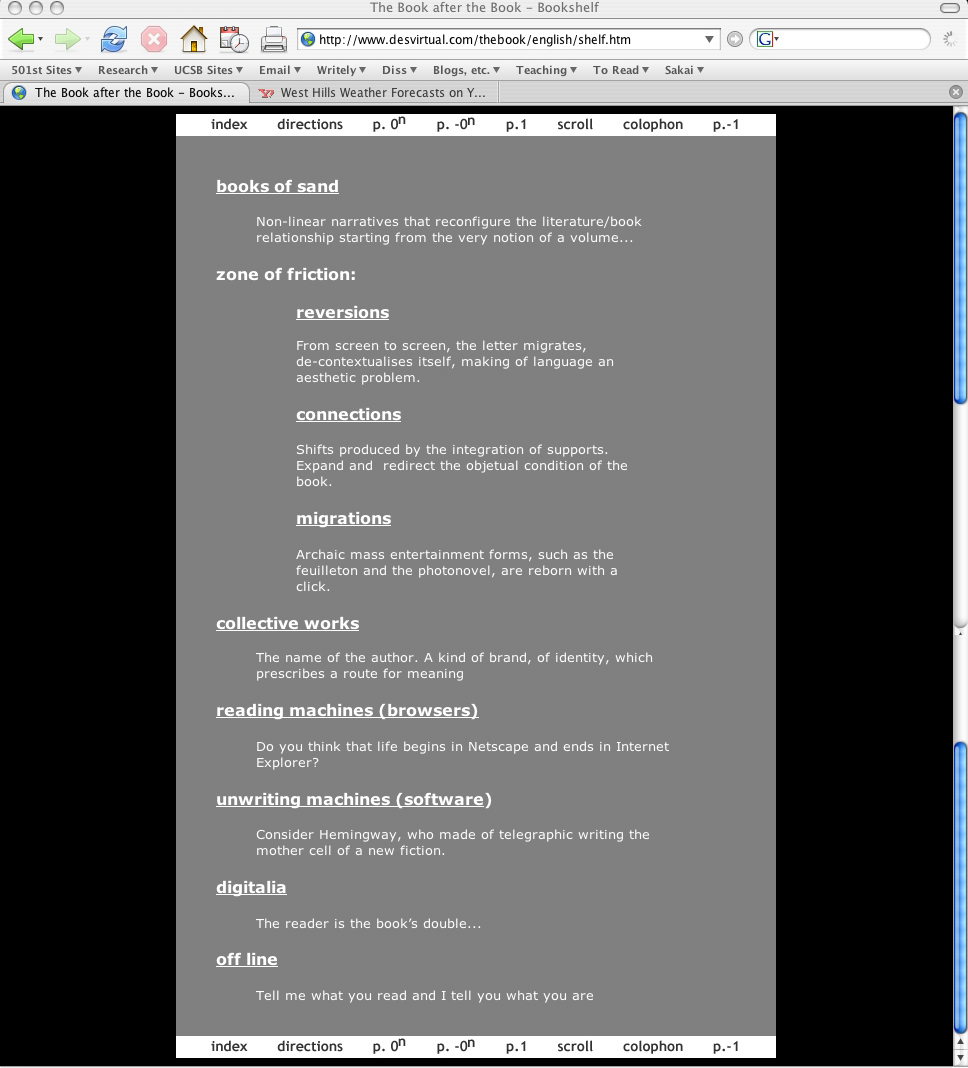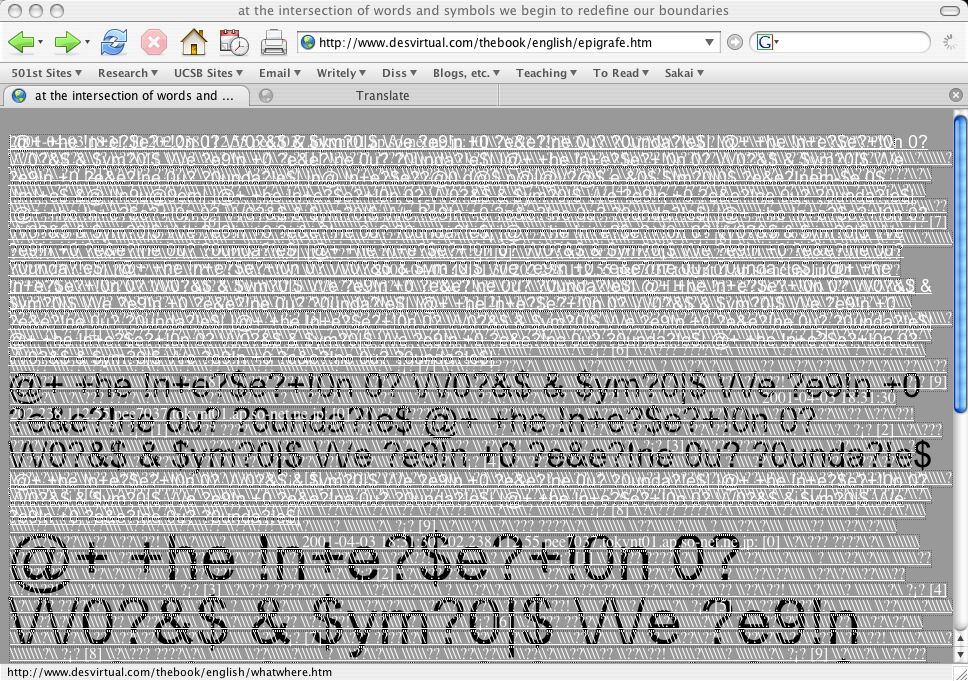Related Categories: New Reading Interfaces | Text and Multimedia | Literacy Studies
Summary:
The Book after the Book by Giselle Beiguelman (1999) is an extended commentary upon online reading in the form of an online hypertext. Set against a flickering background of javascript, the prologue reads, “After more than 500 years, we are facing the development of a new form of written culture which is an hybrid of digital and printed substrata. The library idea does not organize knowledge anymore. It functions as node of a network, a set of revolving shelves, a new reading machine.” Modeled after Jorge Luis Borges’ “Book of Sand,” The Book after the Book seeks an understanding of the ways in which hypertext and online reading change the ways we think about the book as volume, the library as place, and the relationship between image and text. The work includes the artist’s commentary on online reading as well as a repository of links to various “ways of reading” online.
Description:
Published by Brazilian media artist Giselle Beiguelman in 1999, The Book after the Book won the Vitae Foundation’s Arts Award. Writing shortly after the initial internet boom, and amidst an environment in which the internet is celebrated for its democratizing possibilities, Beiguelman is careful to avoid a reductive analysis of online reading. Rather than focusing on the machine as a tool of democracy, she is interested in the ways in which the machine alters reading and the multiple roles of the machine in the reading process – the machine as reader (browsing tools, etc.), the machine as writer (automatic text generators, etc.) and the machine as interface between the reader and the text.
Arguments
As all interfaces must, the computer changes the reader’s relationship to content. To begin with, the “book” can no longer be bound in a volume. There is a long history of books referring to one another through various forms of citation. Certainly one could make the argument that these sorts of in-text references trouble the boundaries between discrete works. The Book after the Book, however, extends this idea by including other “books” as part of its content. For example, in a traditional codex, one author might quote another. Here, in Beiguelman’s work, the reader is referred to the entirety of another work. These references do not function like traditional links, but actually invoke the other works as part of Beiguelman’s argument. Thus, The Book after the Book functions very much like Borges’ “Book of Sand.” It has no discernible beginning or end and due to the hyperlinked nature of the web, its pages are infinite. In Beiguelman’s words, “The Book after the Book [...] implodes the notion of a volume.”
If the notion of the volume is imploded, this must have consequences for the notion of the library, the traditional repository of the volume. Beiguelman argues that the library no longer contains content, in the traditional sense. One of the pages of The Book after the Book is called “bookshelf.” However, this is no ordinary bookshelf. This is the section, referenced above, in which Beiguelman refers the reader to other works. Divided into 9 “revolving shelves” the bookshelves link to content held in other locations. Acting as something more than a link, the shelves take the reader to an interstitial space. For instance, when one selects the shelf entitled “connections,” one is taken to a black page with a series of gray bars that seem to fade into the black. Before one can access the resources on the bookshelf, one is forced to contemplate this animated image. Eventually, one realizes that another reading of the image is possible. Rather than reading the gray bars as disappearing, one might read them as becoming black, as becoming part of the larger whole. When one clicks on the animated image, one is taken to the shelf, where the description reads, “Mediatic shifts made of different reading supports. They are artistic works (of diverse natures) that expand and redirect the objetual meaning of the book and its forms of reading.” By grouping a selection of texts under the heading “connections,” Beiguelman is making an argument about the way we conceptualize texts. Furthermore, by forcing the reader through an interstitial space that makes the same argument in visual form, she reinforces the importance of her organizational strategy.
The organizational strategy of the shelf is important for understanding the way that Beiguelman approaches online reading. “Books of sand” and “zone of friction, ” with the three sub-shelves “reversion,” “migrations,” and “connections,” continue the work of imploding the volume. These shelves point to works in which the volume is reconceived in terms of what counts as literature, how various interfaces affect reading, and what happens when traditional works or forms are digitized. The shelves “collective works” and ”(un)writing machines” question traditional notions of authorship, while “reading machines” focuses specifically on the browser as machine reader. “digitalia” and “offline” are the only two shelves that do not send the reader to an interstitial space before they can access the information. Both refer readers to works of theory, “digitalia” containing online articles and reprints, while “offline” contains references to print books. Pointing in so many directions, the library thus functions as a node in a network rather than as a repository. By moving the library away from the notion of a static place, Beiguelman is able to raise important questions through the way that additional works are linked or invoked. For instance, Beiguelman’s linking to works like Jeffrey Shaw’s “Legible City” asks the reader to reconsider how he would define “book” or to consider whether the notion of the “book” is even relevant. The inclusion of multi-author works force the reader to consider similar questions about authorship, and so on.
Organization
This organizational strategy is part of the argument of The Book after the Book. However, the “bookshelf” is not the only organizing principle of the work, nor is it the first way that one encounters the content of Beiguelman’s book. When one initially enters the site, one encounters a title page. From here, one is taken to an epigraph. The epigraph page consists of layers of white code-like text placed one over another, making the page very difficult to read. At first glance, the use of symbols and letters make the text seem like programming language. Upon closer inspection, however, one can see one layer of symbols, such as ”\\\\°ï¬‚”. A layer that presumably has no meaning. However, on top of this layer, symbols and letters combine to spell out the title of the page: “at the intersection of words and symbols we begin to redefine our boundaries.” This phrase is highlighted in black font in various sizes throughout the page, foregrounding the ways in which meaning emerges from “code.”
Clicking anywhere on the epigraph page will take the user to the Index, the first of three organizational strategies underlying The Book after the Book.
The Index page outlines a directory of files available on the site, most names with some form of page numbering. For example the first three files listed are “p.0n,” “p.-0,” and “p.-0n”. Although these title names give the appearance of page numbers, it is clear from the numbering scheme that this is not a conventional table of contents. In fact, the “Grammatology” page instructs the reader that not all content is accessible directly from the index, for “After all, again recalling Borges, is there a better place than a forest to lose a leaf?” (Beiguelman).

It is from the Index that one encounters the “bookshelf.” As mentioned previously, the bookshelf is divided into sections, which in turn link to various works of print theory, new media art, and machine readers and writers.

The index and the bookshelf function as visible organizing strategies. The third organizing principle is less visible and is explained on the “Grammatology” page. Text appears across the screen as though it is being inscribed by a typewriter, informing the reader that the website “would like to be part of Jorge Luis Borges’ Book of Sand.” The third organizing principle, perhaps best understood through Aarseth’s concepts of aporia and epiphany, is that of looking for a lost leaf in the forest. The “leaves” consist of the various hidden animations and pages that one finds throughout Beiguelman’s work.
Animations
Many of the animations contained within The Book after the Book are found neither in the Index, nor on the bookshelf. Most of these interstitial sections of the text seem to concerned with applying pressure to the boundaries between image and text. Under this pressure, image is revealed to be more than image. Beyond the visual, any online image is reliant upon the text of the code underlying the page. In addition, the image, something generally perceived through the eye, is given an additional sensory dimension when we conceive of it in terms of “weight” (the size and download speed of the image file). Under similar scrutiny, text is revealed to be both illusory and layered. Beneath the text, lies the text of the code. Thus what we think we are seeing when we look at the surface of the web page is not actually text, but the representation of the code: text as image.
Research Context:
In many ways, Beiguelman’s aesthetic can be closely aligned with book design, a form that she acknowledges may be “the most perfect design of all cultural forms since then.” The monochromatic colors and directory-style format of the index and bookshelf recall the tendency of codex works to use black & white print and tables-of-contents. Beyond the seemingly timeless design, Beiguelman points to important questions still under consideration in terms of reading interfaces and the triangulated relationship between machine, content, and reader. These questions include how the interface affects the reading process, how one defines discrete texts in a networked reading environment, what happens when the machine reads and writes, etc.
Technical Analysis:
The pages of The Book after the Book are constructed in HTML and hosted on Beiguelman’s site, http://desvirtual.com. Animated images are mostly GIFs, with a few embedded java applets.
Evaluation of Opportunities/Limitations for the Transliteracies Topic:
Beiguelman’s project could be useful to the Transliteracies project in a few different ways. If nothing else, the work is important for its place in an ecology of thinking about online reading and multimedia textuality. Beyond this, the bookshelves present a catalog of works that the project may wish to consider for inclusion under Objects for Study (some of the entries point to broken links, although they may be available via The Internet Archive). In addition, the ways in which the author divides the bookshelf points to different ways of conceptualizing online reading, such as the difference between the machine and human reader. And finally, many of the questions she asks, although they were raised several years ago, are still applicable to the Transliteracies project. The question of how text, image, reader, and network interact seems to be fundamental to the direction of the project.
Resources for Further Study:
- Beiguelman, Giselle. The Book after the Book. Retrieved November 4, 2006.
- Beiguelman, Giselle. “Bookshelf” In The Book after the Book. Retrieved November 4, 2006.

